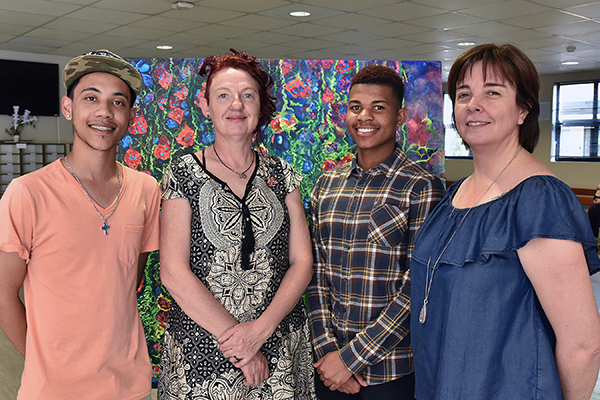
At the event were, from the left: Tristan Nel, first-year Fine Arts student;
Dr Janine Allen-Spies from the Department of Fine Arts;
Prof Carlien Pohl-Albertyn from the Department of Microbiology,
Biochemical and Food Biotechnology; and Pheny Mokawane, a
Microbiology, Biochemical and Food Biotechnology student.
Photo: Charl Devenish
Although BioArt dates back as far as the 15th and 16th centuries with the work of Leonardo da Vinci, it is not every day that art and science combine. This rare phenomenon made its appearance when two totally different groups of students – studying arts and microbiology respectively – joined hands in an initiative to create BioArt.
This first-time undergraduate teaching collaboration between the Departments of Fine Arts and Microbial, Biochemical and Food Biotechnology at the University of the Free State (UFS), which is characterised by the use of living materials, such as enzymes, microbes and DNA, as well as scientific tools and methods, is exploring a number of questions.
Different outcomes for arts and microbiology students
According to Prof Carlien Pohl-Albertyn from the Department of Microbiology, Biochemical and Food Biotechnology, one of the central questions explored in BioArt is the nature of ‘life’. “At which stage can matter be classified as being alive or living?” she asked.
“We realised that the outcomes for the two groups of students would not be the same. For the microbiology students, the focus would be on the understanding and effective communication of a microbiological concept. For the art students the focus would be on the execution of the assignment using visual elements and applied theory of art,” said Prof Pohl-Albertyn.
Dr Janine Allen-Spies from the Department of Fine Arts added: “Art students will also be exploring strangely or previously unforeseen gaps between art and science that can be filled with imaginative interpretations which may forward creative insights in both BioArt as a developing art form and microbiology as investigative science.”
Students’ understanding of microbial evolution reflected in art
The art students had to visit the microbiology labs for their assignment as this is mostly a foreign environment for these students. “The paint medium they had to use was gouache. This medium with its bright colours works well to depict microscopic organisms in art,” Dr Allen-Spies said.
On display at the Department of Microbial, Biochemical and Food Biotechnology on the Bloemfontein Campus, at a recent event to introduce this new initiative to a wider audience, was a range of visually and scientifically compelling paintings and artefacts (such as paintings, poems, songs, apps) which explore a theme within microbiology from a BioArt perspective that uses creativity to communicate concepts dealt with in the module Microbial Evolution and Diversity.
Any parties who are interested in buying the art can contact Dr Allen-Spies at allenj@ufs.ac.za.
Paintings and artefacts reflects students understanding of BioArt. At the recent opening of the BioArt exhibition at the UFS Department of Microbial, Biochemical and Food Biotechnology, was the work of Madeleen Jansen van Rensburg on display.
Pheny Mokawane, a Microbiology, Biochemical and Food Biotechnology student, wrote a poem for his BioArt project in the Microbial Evolution and Diversity assignment.